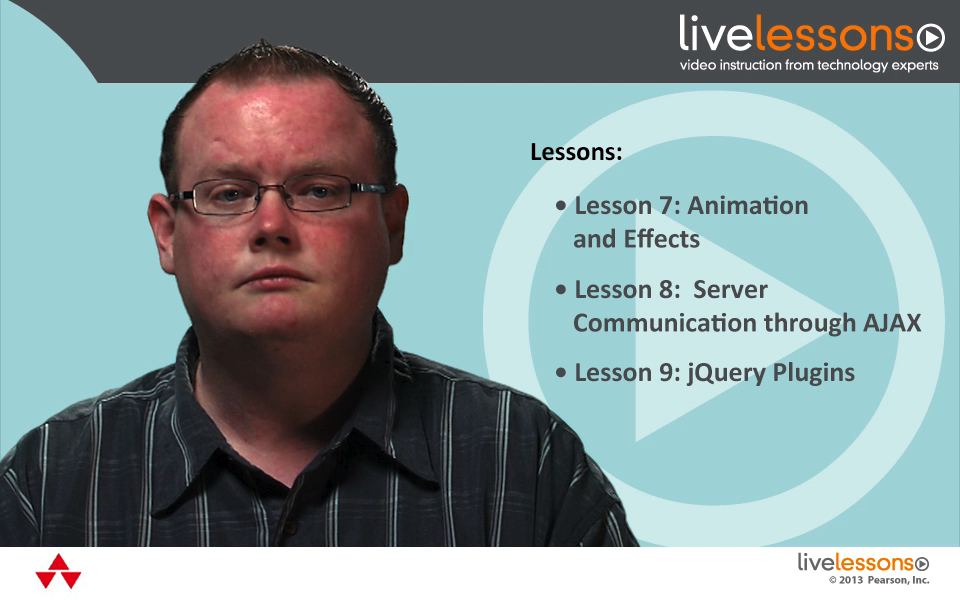jQuery Fundamentals LiveLessons (Video Training), Downloadable Version
- By Phil Dutson
- Published Jan 15, 2013 by Addison-Wesley Professional. Part of the LiveLessons series.
Downloadable Video
- Sorry, this book is no longer in print.
- About this video
Accessible from your Account page after purchase. Requires the free QuickTime Player software.
Videos can be viewed on: Windows 8, Windows XP, Vista, 7, and all versions of Macintosh OS X including the iPad, and other platforms that support the industry standard h.264 video codec.
Register your product to gain access to bonus material or receive a coupon.
Description
- Copyright 2013
- Edition: 1st
- Downloadable Video
- ISBN-10: 0-321-90177-0
- ISBN-13: 978-0-321-90177-4
4+ Hours of Video Instruction
jQuery Fundamentals LiveLessons covers the core jQuery library. This library gives you an easy to use solution that will enhance the functionality and use of your website.
Developer and author, Phil Dutson, focuses each lesson in jQuery Fundamentals on a particular portion of the jQuery library, and by the end viewers should be proficient in using jQuery, as well as writing their own plugins. Viewers will learn how to set up a development environment, including a web server, in both Windows and OS X; use a selector and refine the elements selected; move around the Document Object Model (DOM) tree to selected elements; manipulate the DOM; change attributes and styles; utilize Event handling; add animations and effects; load data remotely through various Ajax calls and actions; and finally, how to use jQuery plugins and how to create their own.
Table of Contents:
Introduction
Lesson 1: Setting Up a Development Environment
Learning objectives
1.1 Download and install the XAMPP web server for OS X
1.2 Download and install the XAMPP web server for Windows 7
1.3 Download and install the Sublime Text 2 text editor for OS X
1.4 Download and install the Sublime Text 2 text editor for Windows 7
1.5 Test a simple HTML page
Lesson 2: Introduction to jQuery
Learning objectives
2.1 Understand the different versions of jQuery
2.2 Add jQuery to the page
2.3 Use a Content Delivery Network (CDN)
2.4 Understand the jQuery Selector
2.5 Use the basic selector filters
2.6 Use the child selector filters
2.7 Use the content selector filters
2.8 Use the form selector filters
Lesson 3: Traversing the Document Object Model (DOM)
Learning objectives
3.1 Define the Document Object Model (DOM)
3.2 Use methods for filtering
3.3 Traverse the DOM tree
3.4 Use other filtering functions
Lesson 4: Manipulating the DOM
Learning objectives
4.1 Wrap elements
4.2 Insert elements
4.3 Remove elements
4.4 Replace elements
4.5 Copy elements
Lesson 5: Modifying Attributes and Styles
Learning objectives
5.1 Change attributes
5.2 Change styles
5.3 Work with dimensions
5.4 Get the offset
5.5 Use data attributes
Lesson 6: Event Handling
Learning objectives
6.1 Use document loading
6.2 Use browser events
6.3 Use mouse events
6.4 Use keyboard events
6.5 Attach event handlers
Lesson 7: Animation and Effects
Learning objectives
7.1 Use Simple effects
7.2 Use Fade effects
7.3 Use Slide effects
7.4 Create custom animation and effects
Lesson 8: Server Communication through Ajax
Learning objectives
8.1 Perform Ajax setup and use
8.2 Implement Ajax events
8.3 Execute Ajax helper functions
8.4 Apply shorthand Ajax methods
Lesson 9: jQuery Plugins
Learning objectives
9.1 Implement third-party jQuery plugins
9.2 Use the jQuery plugin architecture
9.3 Build a jQuery plugin
9.4 Implement the plugin
Summary
More Information

